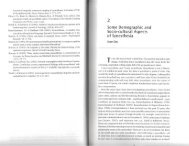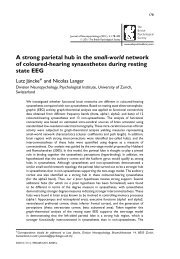1086 Fig. 1 e (A) Synaesthetes showed higher levels of <strong>positive</strong> (UnEx) <strong>and</strong> <strong>disorganised</strong> <strong>schizotypy</strong> (CogDis) relative to matched control participants, but did not significantly differ on negative <strong>schizotypy</strong> (IntAn) or ImpNon. ± s.e.m. * [ p < .05. (B) Frequency of scores on the UnEx scale for synaesthetes (control mean shown as dashed l<strong>in</strong>e). (C) Frequency of scores on the CogDis scale for synaesthetes (control mean shown as dashed l<strong>in</strong>e). with thought disorder <strong>and</strong> <strong>disorganised</strong> aspects of psychosis, it is comprised of items measur<strong>in</strong>g problems with decisionmak<strong>in</strong>g <strong>and</strong> social anxiety. F<strong>in</strong>ally, the ImpNon scale exam<strong>in</strong>es impulsive, antisocial <strong>and</strong> eccentric forms of behaviour (Cochrane et al., 2010; Mason <strong>and</strong> Claridge, 2006). A 2 (Group) 4 (Schizotypal Factor) mixed ANOVA was used to explore differences on each component of <strong>schizotypy</strong> between the groups. A ma<strong>in</strong> effect of group was observed [F(1, 58) ¼ 7.49, p ¼
these cognitive manifestations (e.g., Barnett <strong>and</strong> Newell, 2008; Ward et al., 2008). Therefore, <strong>in</strong> conjunction with mental imagery <strong>and</strong> creativity, <strong>in</strong>creased <strong>positive</strong> <strong>and</strong> <strong>disorganised</strong> <strong>schizotypy</strong> may reflect a constellation of trait markers that are l<strong>in</strong>ked to synaesthesia. In this context, it is <strong>in</strong>terest<strong>in</strong>g to note that one mechanism that has been suggested to expla<strong>in</strong> the relationship between <strong>in</strong>creased <strong>schizotypy</strong> <strong>and</strong> both creativity <strong>and</strong> mental imagery is a difference <strong>in</strong> levels of <strong>in</strong>hibition/ excitation (e.g., Grossberg, 2000; Nelson <strong>and</strong> Rawl<strong>in</strong>gs, 2010). A similar hypothesis has been suggested as a mechanism contribut<strong>in</strong>g towards synaesthesia (Grossenbacher <strong>and</strong> Lovelace, 2001; Brang <strong>and</strong> Ramach<strong>and</strong>ran, 2008). While, as yet, there is a lack of direct evidence exam<strong>in</strong><strong>in</strong>g differences <strong>in</strong> cortical <strong>in</strong>hibition <strong>in</strong> synaesthesia, this offers one plausible mechanism of neural development that may associate synaesthesia, <strong>schizotypy</strong>, creativity <strong>and</strong> mental imagery. Del<strong>in</strong>eat<strong>in</strong>g the relative contributions that extended cognitive manifestations <strong>and</strong> alterations <strong>in</strong> neural development have on the relationship between synaesthesia <strong>and</strong> <strong>schizotypy</strong> will provide important <strong>in</strong>sights <strong>in</strong>to the mechanisms that mediate the developmental of typical <strong>and</strong> atypical perceptual experiences. Acknowledgements MJB is supported by a British Academy Postdoctoral Fellowship. This work was partly supported by an MRC grant to VW. references Barnett KJ, Foxe JJ, Molholm S, Kelly SP, Shalgi S, Mitchell KJ, et al. Differences <strong>in</strong> early sensory-perceptual process<strong>in</strong>g <strong>in</strong> synesthesia: A visual evoked potential study. NeuroImage, 43(3): 605e613, 2008. cortex 48 (2012) 1085e1087 1087 Barnett K <strong>and</strong> Newell FN. Synaesthesia is associated with enhanced, self rated imagery. Consciousness <strong>and</strong> Cognition, 17(3): 1032e1039, 2008. Brang D <strong>and</strong> Ramach<strong>and</strong>ran VS. Psychopharmacology of synesthesia; the role of seroton<strong>in</strong> S2a receptor activation. Medical Hypotheses, 70(4): 903e904, 2008. Burrack A, Knoch D, <strong>and</strong> Brugger P. Mitempf<strong>in</strong>dung <strong>in</strong> synaesthetes: Co-<strong>in</strong>cidence or mean<strong>in</strong>gful association. Cortex, 42(2):151e154, 2006. Cochrane M, Petch I, <strong>and</strong> Picker<strong>in</strong>g AD. Do measures of schizotypal personality provide non-cl<strong>in</strong>ical analogues of schizophrenic symptomatology. Psychiatry Research, 176(2e3): 150e154, 2010. CohenKadoshR<strong>and</strong>HenikA.Cansynaesthesiaresearch<strong>in</strong>form cognitive science? Trends <strong>in</strong> Cognitive Sciences, 11(4): 177e184, 2007. Eagleman DM, Kagan AD, Nelson SS, Sagaram D, <strong>and</strong> Sarma AK. A st<strong>and</strong>ardized test battery for the study of synesthesia. Journal of Neuroscience Methods, 159(1): 139e145, 2007. Grossberg S. How halluc<strong>in</strong>ations may arise from bra<strong>in</strong> mechanisms of learn<strong>in</strong>g, attention, <strong>and</strong> volition. Journal of the International Neuropsychological Society, 6(5): 583e592, 2000. Grossenbacher PG <strong>and</strong> Lovelace CT. Mechanisms of synesthesia: Cognitive <strong>and</strong> physiological constra<strong>in</strong>ts. Trends <strong>in</strong> Cognitive Sciences, 5(1): 36e41, 2001. Mason O <strong>and</strong> Claridge G. The OxfordeLiverpool <strong>in</strong>ventory of feel<strong>in</strong>gs <strong>and</strong> experiences (O-LIFE): Further descriptions <strong>and</strong> extended norms. Schizophrenia Research, 82(2e3): 203e211, 2006. Nelson B <strong>and</strong> Rawl<strong>in</strong>gs D. Relat<strong>in</strong>g <strong>schizotypy</strong> <strong>and</strong> personality to the phenomenology of creativity. Schizophrenia Bullet<strong>in</strong>, 36(2): 388e399, 2010. Oertel V, Rotarska-Jagiela A, van de Ven V, Haenschel C, Grube M, Stangier U, et al. Mental imagery vividness as a trait marker across the schizophrenia spectrum. Psychiatry Research, 167(1e2): 1e11, 2009. Simner J, Mulvenna C, Sagiv N, Tsakanikos E, Witherby SA, Fraser C, et al. Synaesthesia: The prevalence of atipica crossmodal experiences. Perception, 35(8): 1024e1033, 2006. Terhune DB. The <strong>in</strong>cidence <strong>and</strong> determ<strong>in</strong>ants of visual phenomenology dur<strong>in</strong>g out-of-body experiences. Cortex, 45(2): 236e242, 2009. Ward J, Thompson-Lake D, Ely R, <strong>and</strong> Kam<strong>in</strong>ski F. Synaesthesia, creativity <strong>and</strong> art: What is the l<strong>in</strong>k? British Journal of Psychology, 99(Pt1): 127e141, 2008.




